Input interpretation

ammonia + bromine ⟶ nitrogen + hydrogen bromide
Balanced equation
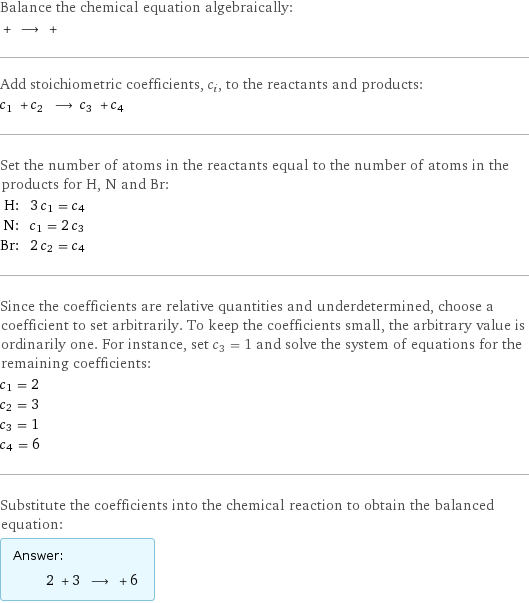
Balance the chemical equation algebraically: + ⟶ + Add stoichiometric coefficients, c_i, to the reactants and products: c_1 + c_2 ⟶ c_3 + c_4 Set the number of atoms in the reactants equal to the number of atoms in the products for H, N and Br: H: | 3 c_1 = c_4 N: | c_1 = 2 c_3 Br: | 2 c_2 = c_4 Since the coefficients are relative quantities and underdetermined, choose a coefficient to set arbitrarily. To keep the coefficients small, the arbitrary value is ordinarily one. For instance, set c_3 = 1 and solve the system of equations for the remaining coefficients: c_1 = 2 c_2 = 3 c_3 = 1 c_4 = 6 Substitute the coefficients into the chemical reaction to obtain the balanced equation: Answer: | | 2 + 3 ⟶ + 6
Structures

+ ⟶ +
Names

ammonia + bromine ⟶ nitrogen + hydrogen bromide
Reaction thermodynamics
Enthalpy
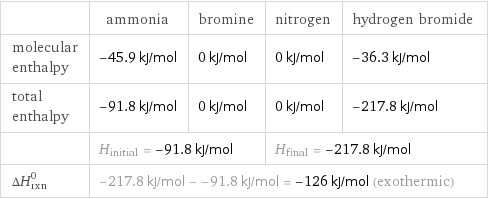
| ammonia | bromine | nitrogen | hydrogen bromide molecular enthalpy | -45.9 kJ/mol | 0 kJ/mol | 0 kJ/mol | -36.3 kJ/mol total enthalpy | -91.8 kJ/mol | 0 kJ/mol | 0 kJ/mol | -217.8 kJ/mol | H_initial = -91.8 kJ/mol | | H_final = -217.8 kJ/mol | ΔH_rxn^0 | -217.8 kJ/mol - -91.8 kJ/mol = -126 kJ/mol (exothermic) | | |
Gibbs free energy
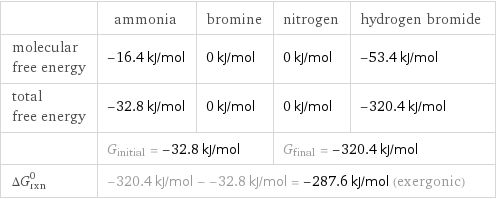
| ammonia | bromine | nitrogen | hydrogen bromide molecular free energy | -16.4 kJ/mol | 0 kJ/mol | 0 kJ/mol | -53.4 kJ/mol total free energy | -32.8 kJ/mol | 0 kJ/mol | 0 kJ/mol | -320.4 kJ/mol | G_initial = -32.8 kJ/mol | | G_final = -320.4 kJ/mol | ΔG_rxn^0 | -320.4 kJ/mol - -32.8 kJ/mol = -287.6 kJ/mol (exergonic) | | |
Entropy
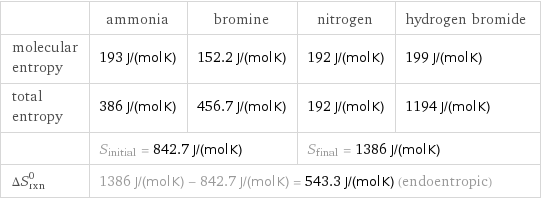
| ammonia | bromine | nitrogen | hydrogen bromide molecular entropy | 193 J/(mol K) | 152.2 J/(mol K) | 192 J/(mol K) | 199 J/(mol K) total entropy | 386 J/(mol K) | 456.7 J/(mol K) | 192 J/(mol K) | 1194 J/(mol K) | S_initial = 842.7 J/(mol K) | | S_final = 1386 J/(mol K) | ΔS_rxn^0 | 1386 J/(mol K) - 842.7 J/(mol K) = 543.3 J/(mol K) (endoentropic) | | |
Equilibrium constant
![K_c = ([N2] [HBr]^6)/([NH3]^2 [Br2]^3)](../image_source/db897bf358b6dc6edc04c89fa19fb8ca.png)
K_c = ([N2] [HBr]^6)/([NH3]^2 [Br2]^3)
Rate of reaction
![rate = -1/2 (Δ[NH3])/(Δt) = -1/3 (Δ[Br2])/(Δt) = (Δ[N2])/(Δt) = 1/6 (Δ[HBr])/(Δt) (assuming constant volume and no accumulation of intermediates or side products)](../image_source/7382e046e6ce615b157431e701e95d98.png)
rate = -1/2 (Δ[NH3])/(Δt) = -1/3 (Δ[Br2])/(Δt) = (Δ[N2])/(Δt) = 1/6 (Δ[HBr])/(Δt) (assuming constant volume and no accumulation of intermediates or side products)
Chemical names and formulas

| ammonia | bromine | nitrogen | hydrogen bromide Hill formula | H_3N | Br_2 | N_2 | BrH name | ammonia | bromine | nitrogen | hydrogen bromide IUPAC name | ammonia | molecular bromine | molecular nitrogen | hydrogen bromide
Substance properties
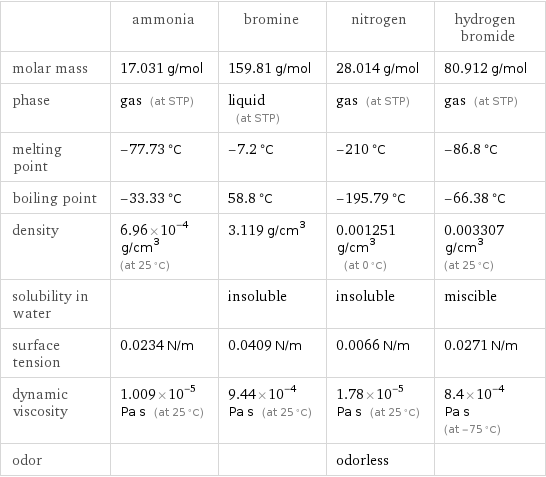
| ammonia | bromine | nitrogen | hydrogen bromide molar mass | 17.031 g/mol | 159.81 g/mol | 28.014 g/mol | 80.912 g/mol phase | gas (at STP) | liquid (at STP) | gas (at STP) | gas (at STP) melting point | -77.73 °C | -7.2 °C | -210 °C | -86.8 °C boiling point | -33.33 °C | 58.8 °C | -195.79 °C | -66.38 °C density | 6.96×10^-4 g/cm^3 (at 25 °C) | 3.119 g/cm^3 | 0.001251 g/cm^3 (at 0 °C) | 0.003307 g/cm^3 (at 25 °C) solubility in water | | insoluble | insoluble | miscible surface tension | 0.0234 N/m | 0.0409 N/m | 0.0066 N/m | 0.0271 N/m dynamic viscosity | 1.009×10^-5 Pa s (at 25 °C) | 9.44×10^-4 Pa s (at 25 °C) | 1.78×10^-5 Pa s (at 25 °C) | 8.4×10^-4 Pa s (at -75 °C) odor | | | odorless |
Units
